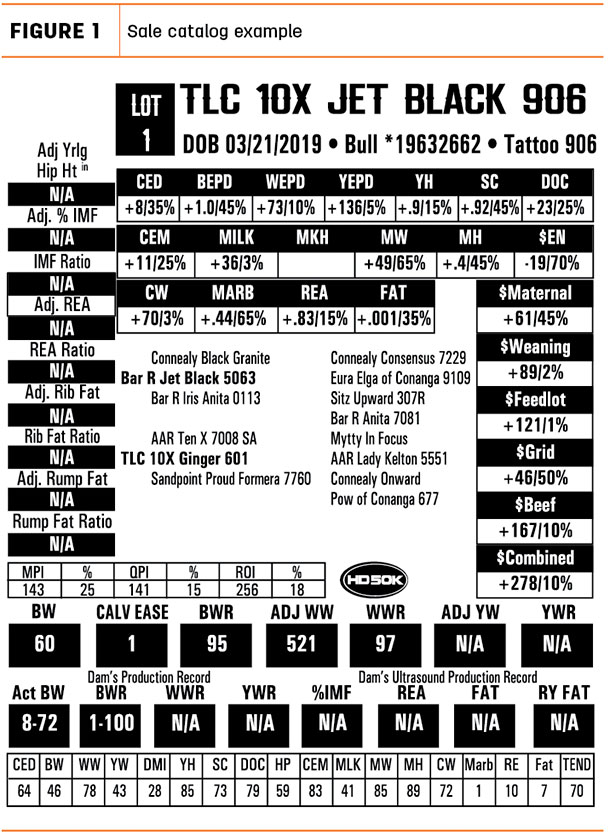Production livestock sales in the West have been happening since last fall: purebred bulls and heifers, commercial heifers, open or bred heifers and young cows of all breeds.
There seems to be a “breeding” market for just about anything. But do you want to purchase “just anything?”
Do you get overwhelmed with all the information available at your fingertips? Talk about being inundated with data; I received a catalog the other day with this inside (Figure 1).

I understand that purebred producers want to provide as much information as possible so buyers can make the best choices for their operations. Unfortunately, buyers are not all looking for the same data, leaving the purebred producer to furnish an overload of information.
When selecting new livestock, one should be evaluating the animals on paper as well as in the corral. Some sales provide video clips of the sale animals prior to the sale date. Those 10- to 20-second clips can provide you with enough information to know if you are interested in investigating further. Doing your homework before the sale will help you make better choices at ringside.
Grab one of those recent sale catalogs you received and follow along as I discuss the five criteria used to evaluate livestock.
1. Growth, frame and skeletal size. You need to know what your herd currently is (small, medium or large frame) and what you want it to be. Feed, available human resources in your operation and your end goal should be the factors used in determining the size of your animals. Big is not always better, even though our eyes will often look first at the big ones. Big frame means more feed required and more pounds produced per animal.
Small frame means less feed required; however, pounds produced can be limiting. You should be reviewing the pictures, footnotes, actual production weights of Birthweight (BW), Weaning Weight (WW) and Yearling Weight (YW), and hip height scores; expected progency differences (EPDs) BW, WW, YW, Mature Height (MH), Mature Weight (MW) and Carcass Weight (CW).
2. Muscling. This criterion is important to beef producers. Heavy-muscled animals produce more meat and less fat. One needs to understand that different breeds yield different amounts; thus each breed has its own purpose. For example, if you want muscling, you are not going to pick a longhorn. In general, the heavier-muscled the animal is, the more risk you have with structure problems. Too much muscle can cause issues with breeding and birthing of all livestock. You should be looking at the following EPDs: Ribeye Area (REA) and CW; and production traits: REA. These numbers can give an indication of what that animal has and will produce.
3. Volume and performance. Why do we want volume? The deeper bodied an animal is, the more they can consume. The more they eat, the more meat and milk they can produce. The quicker they reach market weight or maturity weight, the better. Performance is how well the animal grows over time. You should be looking at the following; EPDs: BW, WW, YW, Scrotal Circumference (SC) and Maternal Milk (MILK); Production traits: actual and adjusted BW, WW, YW, ratios and dam production ratios. All of these are indicators of an animal’s potential for volume and performance.
4. Condition and trimness. These criteria relate to the animal’s performance. Please remember: Breed types are a factor. There is a difference between English breeds and Continental breeds. You must consider the amount of condition needed from that animal’s stage and level of production. For example, assuming you are in a spring-calving situation, a really thin cow in May could mean she is milking a lot for her calf, where a thin cow in November could mean something else.
Condition helps you determine what your management needs are for this new animal: early maturing or later maturing, more or less feed? You should be looking at the following; EPDs: MW, Marbling (Marb), Fat Thickness (Fat); Production traits: Ultra-sound Rib Fat, Rump Fat. These numbers give you an indication of which animal might meet your needs before you head to the corral. Looking at the livestock is the best way to determine condition and trimness.
5. Structure, soundness and balance. Strong bone and correct skeletal structure are important for animals traveling to feed and water, whether that is covering 40 acres or 400 acres. Stock must be able to walk. Having correct structure will help ensure soundness, and they will be more likely to last a while in the herd. Balance is the overall attractiveness of the animal. They should be evenly balanced front to rear. You should be looking at the following; EPDs: claw (set) and (foot) angle; Production traits: Foot notes and dam longevity.
Yes, sale catalogs can be overwhelming, but having all that information at your fingertips provides the opportunity to do your homework prior to attending the sale. Purebred breeders do their best to provide the information needed to help you make informed decisions. Looking over the five criteria above and knowing your environmental and management constraints, you are more likely to pick the bulls, heifers or cows to best fit your needs.
There is much more to livestock selection than what this article can print. Topics such as temperament, bloodlines, $ value indexes, DNA testing and Quality Pounds (QPI), when to market your calf crop and what EPD selection will be best for that market situation. I challenge you to brush up on your knowledge about these tools, then take a look at your breed’s website to learn more about the selection tools at your disposal.








